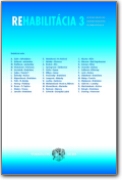Využitie Autoreflexného Zapojenia Hlbokého Stabilizačného Systému U Pacientov Po Operácii Lumbálnej Chrbtice (Literárny Prehľad, Vlastné Pozorovanie, Štatistické Vyhodnotenie)
DOI:
https://doi.org/10.61983/lcrh.v60i3.9Keywords:
lumbar spine, deeps stabilisation system, stability, instability, rehabilitation therapyAbstract
Aim: Aim of this work was to assess the autoreflex connection of deep stabilisation system in patient after lumbar spine surgery
Basis: Lumbar spine surgeries have increasing incidence and allow the improvement of overall state of patients, reduction of pain, improvement of motion and return to normal life without disability. Result of the surgery depends not only on surgical procedure, but also on rehabilitation after the surgery, education of patients concerning the exercise practising in home environment and on the possibility to undergo a good quality complex spa therapy.
Group and methods: 21 patients after lumbar spine surgery were included into this research and statistical analysis from June 2021 to May 2022. The group of 21 patients were aged from 27 to 70 years, 12 men and 9 women, who were after lumbar spine surgery. Surgical procedure was with or without the stabilisation techniques in lumbar segments. Monitored patients were 5-12 months after the surgery. Unfortunately, during the Covid-19 pandemic situation, the outpatient’s rehabilitation care was significantly reduced or closed and therefore many patients did not undergo the rehabilitation outpatient process what might lead to need of surgical solution of their state. All monitored patient had deep stabilisation system (DSS) insufficiency.
Patients performed the exercises 3-4 times a week during 4 weeks. They underwent the hydro kinesiotherapy and group therapeutical exercises focused on DSS restoration, as well as neuro-facilitation techniques (Brunkowa, DNS or McKenzie). The research was prospective study.
Following tests were used in functional spine examination: Thomayer test, Schober test, test of lateral flexion, sit-stance test, and walk test (we used possibilities of the workplace).
To assess the subjective perception, we used the questionnaire from 12 questions, classis VAS scale and adapted questionnaire of quality of life. Data was statistically analysed in verified criteria.
Results from the questionnaires in percentage are listed in the results of our work
Results: The state of patients was significantly improved after the spa therapy in all parameters obtained from entrance questionnaire, the VAS questionnaire, as well as the adapted questionnaire of quality of life. Patients reached after the exercises the improvements in objective parameters and measurements.
Published
How to Cite
Issue
Section
License
Copyright (c) 2023 journal REHABILITÁCIA

This work is licensed under a Creative Commons Attribution-NonCommercial-ShareAlike 4.0 International License.


